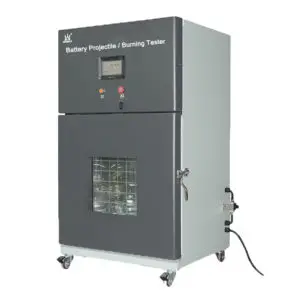Thermal Runaway Test Machine Standards
- UL 2580
- IEC 62619
Relevant standards requirement
- Test objects: The test object is the whole vehicle or the complete vehicle-borne ion battery system or the subsystem of the vehicle-borne lithium-ion battery system, including a lithium ion battery and an electrically connected lithium ion battery.
- Test conditions test shall be started under the following conditions:
- Testing should be started at temperature higher than 0 ℃, relative humidity 15%~90%, and the atmospheric pressure 86~106 kpa.
- Before testing, The SOC of the test object should be adjusted to 90% or 95% of the normal SOC working range specified by the manufacturer.
- Before testing, all the test devices must be running normally.
- The test objects should be modified as little as possible when testing, and the manufacturer should submit a list for all changes.
- Testing should be at the room temperature or wind speed is not more than 2.5 km/h.
- Thermal runaway trigger object Heating and needling are recommended as candidates for the thermal runaway test of lithium ion battery systems. Manufacturers can choose one of them.
Technical Parameters
| Product Name | Thermal Runaway Test Machine |
|---|---|
| Model | BE-8401 |
| Trigger Mode | Overcharging and heating (Optional) |
| Heating Mode Channel | 2 channel(1 in common used, 1 for spare) |
| Max. Heating Power | 3KW, Single channel |
| Power Adjust Mode | Changed the heating tube with different capacity + Adjust the input current. |
| Power Supply | AC 220V 50Hz |
| Max. Overcharging Voltage | 10V and 100V |
| Voltage Acquisition Channel | 2 channel (Customizable) |
| Temp. Acquisition Channel | 4 channel (Customizable) |
| Control Mode | PLC+PC control (PC and main chamber integrated) |
| Control Host Overall Dimension | W700 X D650 X H1360mm |
| Explosion-proof Chamber Dimension | W2000xD3000xH2000mm (Optional) |
| Total Weight | 1000KG |
| Power Supply | AC 220V , 7.0KW |
Thermal Runaway Test Machine Test method
The two methods of heating and nail penetration are recommended as candidates for the thermal diffusion test lithium-ion battery systems. Manufacturers can choose one of these methods or choose other methods to trigger thermal runaway.
Thermal runaway trigger object
- The lithium-ion battery cell in the test object.
- Choose a lithium-ion battery cell close to the center of the lithium-ion battery pack or surrounded by other lithium-ion battery cells and difficult to generate thermal radiation.
Nail penetration triggers thermal runaway
- Nail penetration material: steel
- Nail penetration diameter: 3 mm~8 mm
- Nail penetration tip shape: conical, angle 20°~60°
- Nail penetration speed: 10 mm/s ~100 mm/s
- Nail penetration position and direction: select the position and direction that can trigger the thermal runaway of the lithium ion battery cell (for example, the direction perpendicular to the pole piece). (Cooperate with the nail penetration testing chamber or the nail penetration testing equipment at the bottom of the battery pack to complete the test)
Heating triggers thermal runaway: use planar or rod-shaped heating devices, and the surface should be covered with ceramic, metal, or insulating layer.
For the block heating device with the same size as the lithium-ion battery cell, the heating device can be used to replace one of the lithium-ion battery cells, which is in direct contact with the surface of the trigger object; for the thin-film heating device, it should always be attached to the trigger object.
The heating area of the heating device should not be greater than the surface area of the lithium ion battery cell; the heating surface of the heating device directly contacts the surface of the battery cell, and the position of the heating device should correspond to the position of the temperature sensor.
Start the heating device immediately to heat the triggered object with the maximum power of the heating device; when thermal runaway occurs or the temperature of the defined monitoring point reaches 300℃, stop the trigger.












